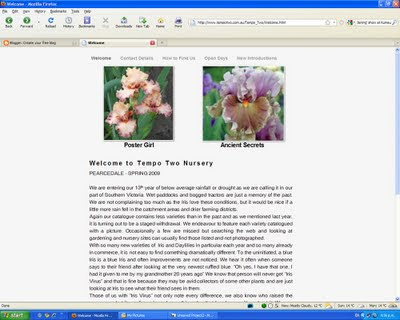Christmas Blessings to you all.
If I had to pick an Iris which epitomised my year it has to be Marbled Mohr. It kinda is one type of Iris but it ain't, and lets face it, when you see such beauty the politics of Iris registration takes a definite back seat. Maybe, it just is one of those situations when,"If it looks like a Arilbred,Grows like an Arilbred, you know, it just might be an Arilbred"
Problems like these in Iris Nomenclature will be eliminated when the meaning of 'Cumulative" is discovered and embraced by more than just the few Iris Societies that have already done so.
Tell's Iris Gardens. Provo, Utah. Iris Catalog and Hybridizers Handbook 1959
Greetings 1959,
Then I have a William Mohr seedling I have kept around a long time because it always performs well. This I have named MARBLED MOHR. It is in the same color-range as SPLASHES but unlike it an easy grower. It carries a fine plicata heritage and I can see its use in a worthy plicata program.
1959 Introductions
MARBLED MOHR* (Tell Muhlestein). Early-Midseason. 40 inches. (William Mohr.) X (47-15 ((Midwest x Mme. Louis Aureau) x (Aldura)).
Large Mohr-type flower of medium violet splashed white'. Good growth and bloom. Could be a great plicata parent. .. .. ... $5.00
Its registered as a Tall Bearded Iris yet the 1959 American Iris Society (AIS) Checklist notes it as a "Mohr Type".
MARBLED MOHR (Muhlestein, R. 1958). TB 40" E-M. V2M. Medium violet, splashed white (Mohr type). William Mohr x (Midwest x Madame Louis Aureau) x Aldura)., Tell 1959.
The Aril Society International (ASI) in its 2006 Checklist notes Marbled Mohr under APPENDIX C "OTHER THAN" [OT] Iris which have been registered with the American Iris Society as "other than" arilbreds. They usually contain 1/4 aril complement.
The Historic Iris Preservation Society has a Comprehensive Checklist of Aril and Arilbred Cultivars: This is an alphabetical checklist of cultivars based on American Iris Society registrations through 1996 and Aril Society International records through 1996. It contains historical information and notes on the cultivars in addition to "standard" checklist information. Compiled by Kay Nelson Keppel and Sharon McAllister.A great example of what a Cumulative Checklist can do and its listing is thus.
MARBLED MOHR AB (Tell Muhlestein, R. 1958). Sdlg # N/A. TB, 40", E-M. William Mohr x ((Midwest x Madame Louis Aureau) x Aldura). Medium violet splashed white. Tell, 1959.
Notes: registered as a TB but qualifies as an OB- in both systems. Ref: AIS '59, p. 122; ASI '76, p.53.
Good to see that someone has got it right. Big Hat tip to Dorothy Stiefel
Available in New Zealand from The Iris Garden so be sure to get your order in.
As always clicking on the above image will take you to the larger, higher resolution version. Reproduction in whole or in part of this post, its opinions or its images without the expressed written permission of Terry Johnson is strictly prohibited. Photo credit and copyright Terry Johnson and Heritage Irises ©.
See you all in the New Year and thanks for visiting in 2009.

























